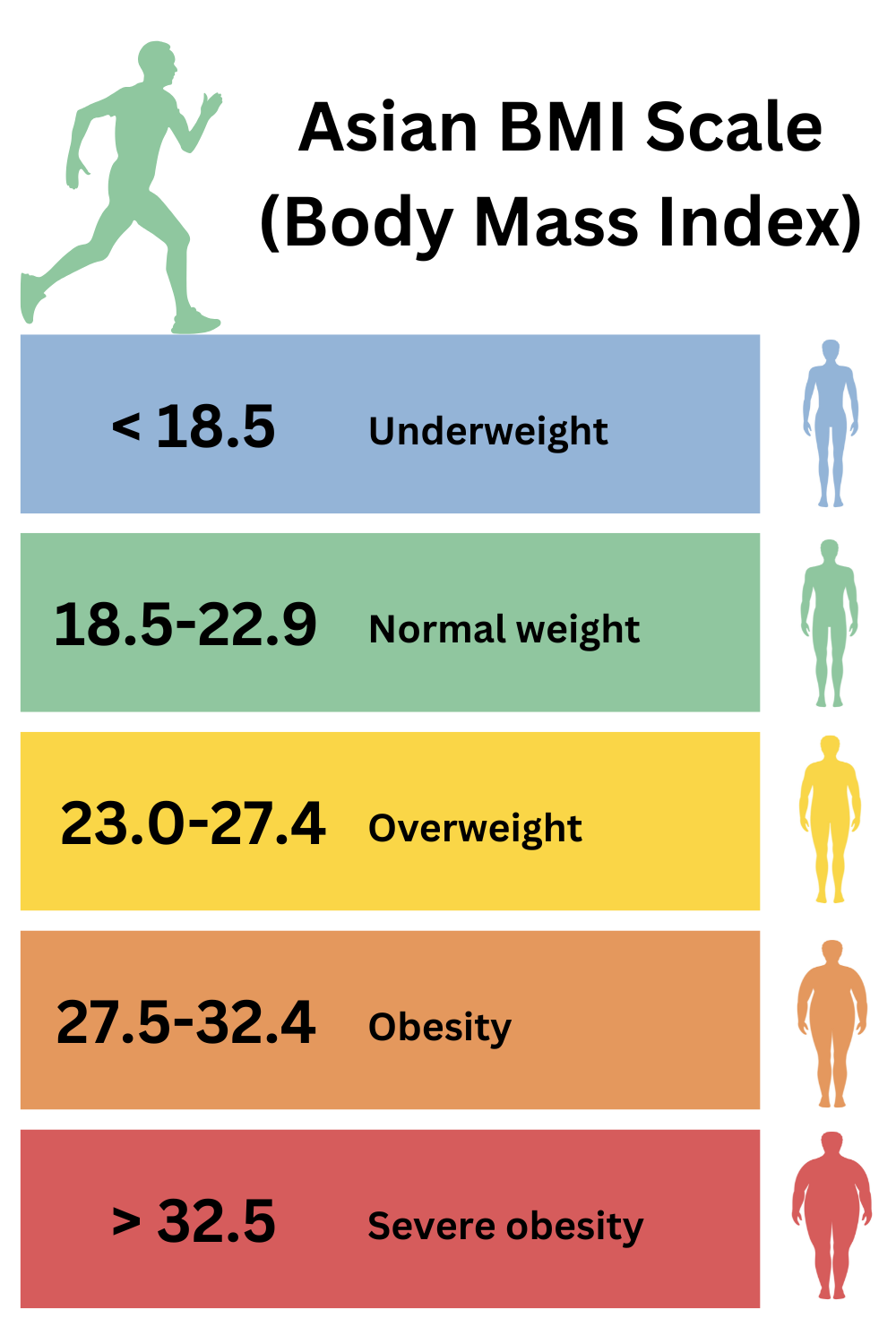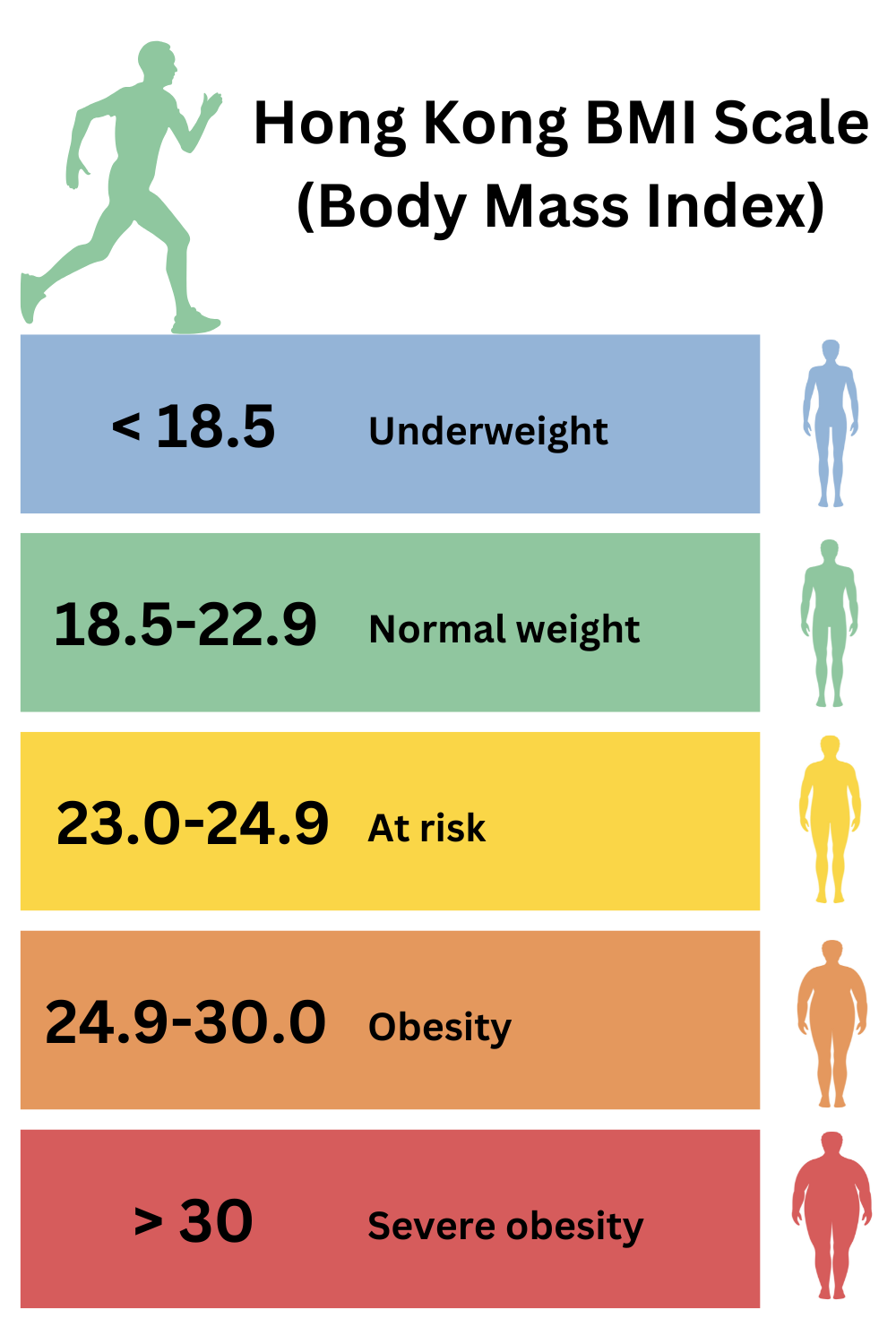Links marked with * — Partner products have been carefully selected by Gym Geek. When you purchase a product through one of these links, we may earn an affiliate commission. As an Amazon Associate we earn from qualifying purchases.
![]()
Most Popular Calculators
Calculators to try next:
What is Asian Body Mass Index?
Asian Body Mass Index (BMI) is calculated in the same way as the standard body mass index. However, the thresholds for overweight, obesity and severe obesity are set lower than the thresholds recommended for North American and European populations.
Our Asian BMI calculator uses the scale defined by the World Health Organization in the year 2004. This scale sets a healthy weight range at 18.5-22.9, compared with the 18.5-24.9 range recommended for Europeans. BMIs between 23 and 27.4 are considered an “Overweight” category, while BMIs above 27.5 are considered obesity.
The lower thresholds have been adopted by public authorities in Asian countries like Singapore and Hong Kong. If you are of Asian ethnicity, these thresholds may provide a more accurate assessment of your body weight and health risks.
Asian BMI Classification
Most Asian countries use BMI ranges defined by the World Health Organization in 2004. The UK’s National Institute for Healthcare Excellence recommends these ranges for persons of Asian ethnicity. It also reduces the thresholds for the obesity categories by 2.5. The BMI ranges used by our calculator are:
- Below 18.5 – Underweight
- Between 18.5 and 22.9 – Normal weight
- Between 23.0 and 27.4 – Overweight
- Between 27.5 and 32.4 – Obesity class I
- Above 32.5 – Obesity class II

The public health authority in Hong Kong uses even smaller thresholds than most Asian countries. These lower BMI ranges were defined by the World Health Organization’s Regional Office for the Western Pacific in the year 2000:
- Below 18.5 – Underweight
- Between 18.5 and 22.9 – Normal weight
- Between 23.0 and 24.9 – At risk (overweight)
- Between 25.0 and 29.9 – Obesity class I
- Above 30.0 – Obesity class II

Why do Asian populations need a different BMI scale?
The health risks associated with obesity occur at a lower BMI for many Asian populations compared to North American or European populations. Because Asians tend to have a higher level of body fat, for the same BMI, the risks of developing obesity-related health conditions like heart disease and diabetes tend to be higher.
Body type and body fat distribution varies across ethnicities. As well as having higher levels of body fat, overweight Asian individuals tend to store more fat around the abdomen – specifically as visceral fat. The amount of visceral fat an individual has is closely related to the risk of metabolic disease.
Visceral fat is the type of fat that accumulates around your vital organs in your abdominal cavity. This type of fat is not the kind that’s visible from the outside, and can only be measured precisely using imaging methods like MRI or CT scans.
Unlike the fat directly beneath your skin, visceral fat is “metabolically active”, meaning it releases hormones and other substances that can cause inflammation and increase your risk of chronic disease.
Excessive amounts of visceral fat have been linked to a higher risk of developing serious health conditions, including:
- Cardiovascular disease – Visceral fat produces inflammatory substances that can damage your blood vessels, increase your blood pressure and increase the risk of heart attack or stroke.
- Type 2 diabetes – Because visceral fat interferes with insulin production and increases your body’s insulin resistance, it can lead to high blood sugar levels and eventually type 2 diabetes.
- Inflammatory diseases – Excessive visceral fat is associated with inflammation in the body. This can lead to chronic inflammatory diseases like arthritis or asthma.
Risks of overweight
According to the CDC, people with a BMI over 25 (overweight and obese), are at an increased risk of disease and health complaints.
Health conditions associated with overweight and obesity include:
- Heart disease and stroke – Extra weight makes you more likely to have high blood pressure and high cholesterol, both risk factors for heart disease and stroke.
- Type 2 diabetes – Overweight and obese individuals are at higher risk of developing type 2 diabetes. A 2007 study showed that being overweight or obese, particularly at a young age, substantially increases the risk of diabetes.
- Cancer – Being overweight or obese is associated with a higher risk of many types of cancer, including lung cancer, colorectal cancer, prostate cancer and breast cancer.
- Osteoarthritis – Excess weight can put unnecessary pressure on joints, leading to wear and tear. The impact of osteoarthritis increases with a higher BMI.
Risks of underweight
A BMI under 18.5 is generally considered underweight. This threshold is the same across all populations and ethnicities. Being underweight is associated with several health risk, including:
- Undernourishment and malnourishment: These conditions occur when your body isn’t receiving the necessary nutrients it needs to function efficiently, leading to tiredness, weakness and other issues. A BMI under 18.5 may put you at risk of becoming under-nourished.
- Osteoporosis: BMI is positively associated with bone mineral density. If you have low bone mineral density, your bones can become fragile, making them more prone to fractures. BMI at the upper end of the normal range (18.5 to 24.9) may reduce the risk of osteoporosis.
Limitations of BMI
The primary limitation of using BMI as a healthy weight indicator is that it does not take into account your body’s fat content. BMI is calculated using only your weight and height, but it doesn’t differentiate between weight from muscle and weight from fat.
If you have a high muscle mass, you may have a high BMI and be categorized as overweight or obese. Athletes and individuals who participate in strength training or other sports that contribute to muscle growth often have higher BMIs.
While BMI can be a useful tool, it should be used in conjunction with other methods when evaluating the state of your overall health and fitness.
Despite its limitations, BMI is a useful measure for the majority of people. BMI can provide a reasonably accurate assessment of whether you are underweight, normal weight, overweight or obese. It is an accessible and easy-to-understand measurement that can be a starting point for deeper conversations about your health, diet, and exercise.
Not suitable for
Do not use our Asian BMI calculator:
- If you are pregnant – BMI will not provide an accurate reflection of your health status as your body undergoes significant changes during pregnancy. Consult a doctor or medical professional if you are concerned about your weight.
- If you have an eating disorder – Always consult a medical professional about your weight.
- If you have a medical condition that affects your height – BMI might not provide a accurate assessment of your health.
- If you are under the age of 18 – BMI is not a suitable measure of healthy weight for children and teens under the age of 18.
How to use our BMI calculator
First, input your height. You can select either feet (ft) and inches (in) or centimeters (cm).
Next, input your weight. You can do this in either kilograms (kg) or pounds (lbs).
Finally, click the “Calculate BMI” button. The calculator will output your BMI value, along with the weight status. This will be one of underweight, normal weight, at risk, obese or severely obese.
BMI Formula
The Body Mass Index (BMI) formula is simple calculation to assess whether you have a healthy weight. The formula for calculating BMI is:
BMI = Weight (kg) / [Height (m)]2
The formula takes your weight in kilograms and divides it by your height squared.
The BMI formula is the same for Asian and non-Asian populations. The only difference with Asian BMI are the thresholds and categories for overweight and obesity.
References
Tan, K. C. B. (2004). Appropriate body-mass index for Asian populations and its implications for policy and intervention strategies. The lancet.
NICE. (2025, January 14). Overview | Overweight and obesity management | Guidance | NICE. https://www.nice.org.uk/guidance/ng246
World Health Organization. (2020). Regional Office for the Western Pacific.(2000). The Asia-Pacific perspective: redefining obesity and its treatment. Sydney: Health Communications Australia. 2000-02)[2021-10-11]. https://apps. who. int/iris/handle/10665/206936.
Centers for Disease Control and Prevention. (2022). The health effects of overweight and obesity. Centers for Disease Control and Prevention; Centers for Disease Control and Prevention. https://www.cdc.gov/healthyweight/effects/index.html
Lu, Y., Hajifathalian, K., Ezzati, M., Woodward, M., Rimm, E. B., Danaei, G., & D’Este, C. (2014). Metabolic mediators of the eff ects of body-mass index, overweight, and obesity on coronary heart disease and stroke: a pooled analysis of 97 prospective cohorts with 1.8 million participants.
Narayan, K. V., Boyle, J. P., Thompson, T. J., Gregg, E. W., & Williamson, D. F. (2007). Effect of BMI on lifetime risk for diabetes in the US. Diabetes care, 30(6), 1562-1566.
Calle, E. E., Rodriguez, C., Walker-Thurmond, K., & Thun, M. J. (2003). Overweight, obesity, and mortality from cancer in a prospectively studied cohort of US adults. New England Journal of Medicine, 348(17), 1625-1638.
Raud, B., Gay, C., Guiguet-Auclair, C., Bonnin, A., Gerbaud, L., Pereira, B., … & Coudeyre, E. (2020). Level of obesity is directly associated with the clinical and functional consequences of knee osteoarthritis. Scientific reports, 10(1), 3601.
Underweight. (n.d.). Great Western Hospital. https://www.gwh.nhs.uk/wards-and-services/nutrition-and-dietetics/specific-support/underweight/
Lee, J. H., Kim, J. H., Hong, A. R., Kim, S. W., & Shin, C. S. (2020). Optimal body mass index for minimizing the risk for osteoporosis and type 2 diabetes. The Korean journal of internal medicine, 35(6), 1432.


